Management and Operations: Leadership Theories and Practices
VerifiedAdded on 2020/06/06
|18
|4653
|49
Report
AI Summary
This report provides a comparative analysis of leaders and managers, highlighting their distinct roles, responsibilities, and characteristics. It delves into various leadership theories and models, including situational leadership, system leadership, contingency leadership, and chaos theory, offering insights into their application within organizational structures. The report examines the roles of leaders and managers in different situational contexts, such as team building, decision-making, and problem-solving. Furthermore, it analyzes the key approaches to operations management and the significance of operations management in achieving business objectives, with a specific focus on the case study of the Wiseman Group. The report also considers factors within the business environment that impact operational management and decision-making. The conclusion summarizes the key findings and provides recommendations for effective leadership and management practices.
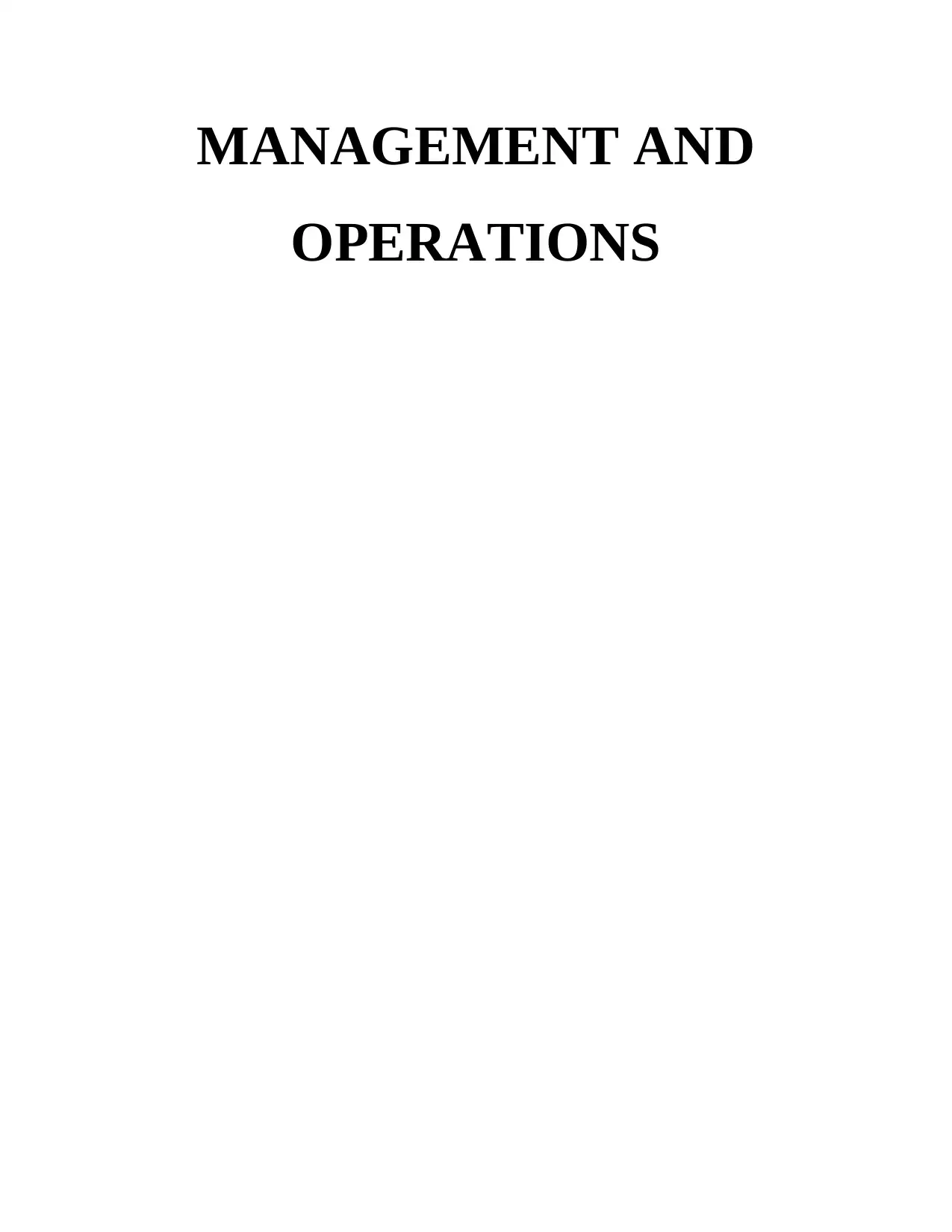
MANAGEMENT AND
OPERATIONS
OPERATIONS
Paraphrase This Document
Need a fresh take? Get an instant paraphrase of this document with our AI Paraphraser
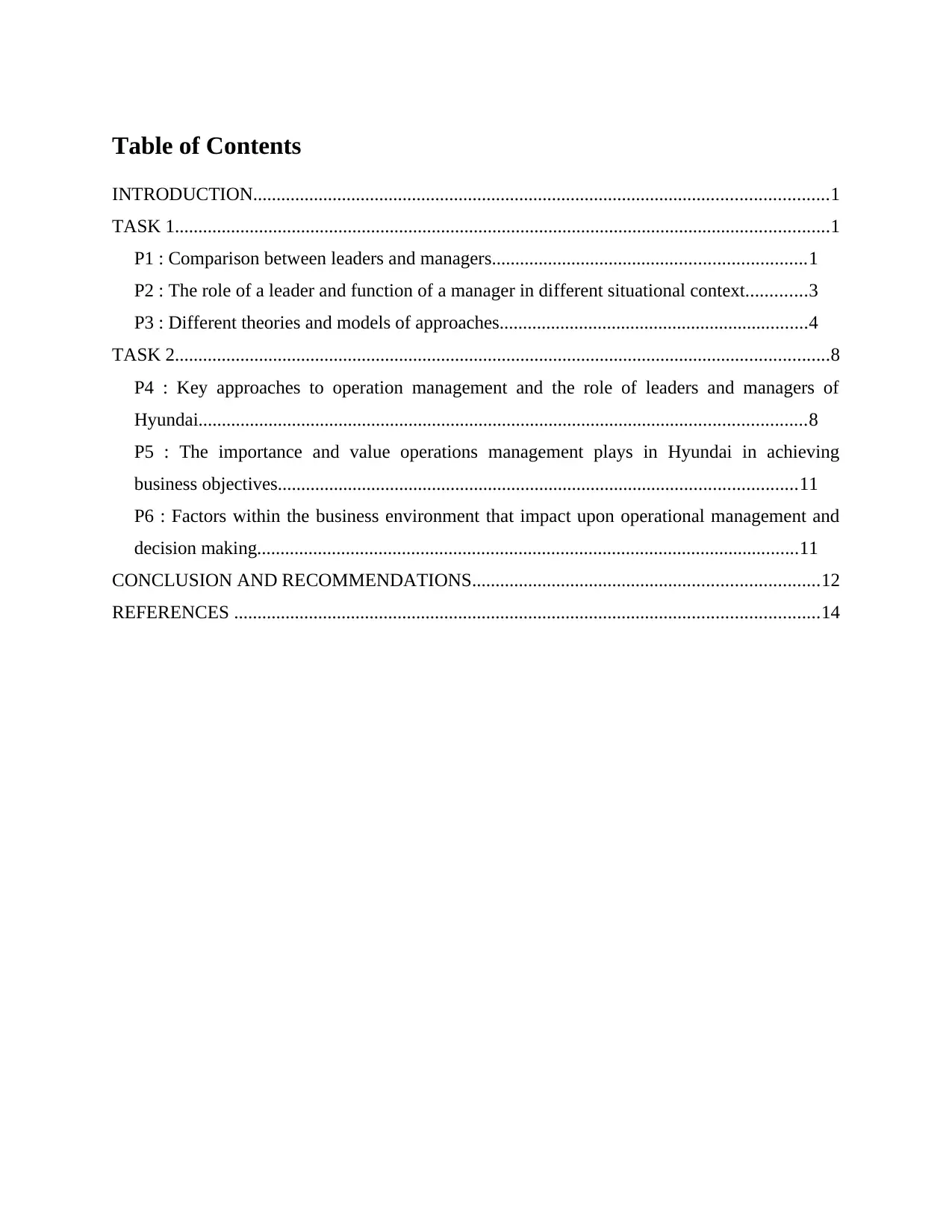
Table of Contents
INTRODUCTION...........................................................................................................................1
TASK 1............................................................................................................................................1
P1 : Comparison between leaders and managers...................................................................1
P2 : The role of a leader and function of a manager in different situational context.............3
P3 : Different theories and models of approaches..................................................................4
TASK 2............................................................................................................................................8
P4 : Key approaches to operation management and the role of leaders and managers of
Hyundai..................................................................................................................................8
P5 : The importance and value operations management plays in Hyundai in achieving
business objectives...............................................................................................................11
P6 : Factors within the business environment that impact upon operational management and
decision making....................................................................................................................11
CONCLUSION AND RECOMMENDATIONS..........................................................................12
REFERENCES .............................................................................................................................14
INTRODUCTION...........................................................................................................................1
TASK 1............................................................................................................................................1
P1 : Comparison between leaders and managers...................................................................1
P2 : The role of a leader and function of a manager in different situational context.............3
P3 : Different theories and models of approaches..................................................................4
TASK 2............................................................................................................................................8
P4 : Key approaches to operation management and the role of leaders and managers of
Hyundai..................................................................................................................................8
P5 : The importance and value operations management plays in Hyundai in achieving
business objectives...............................................................................................................11
P6 : Factors within the business environment that impact upon operational management and
decision making....................................................................................................................11
CONCLUSION AND RECOMMENDATIONS..........................................................................12
REFERENCES .............................................................................................................................14
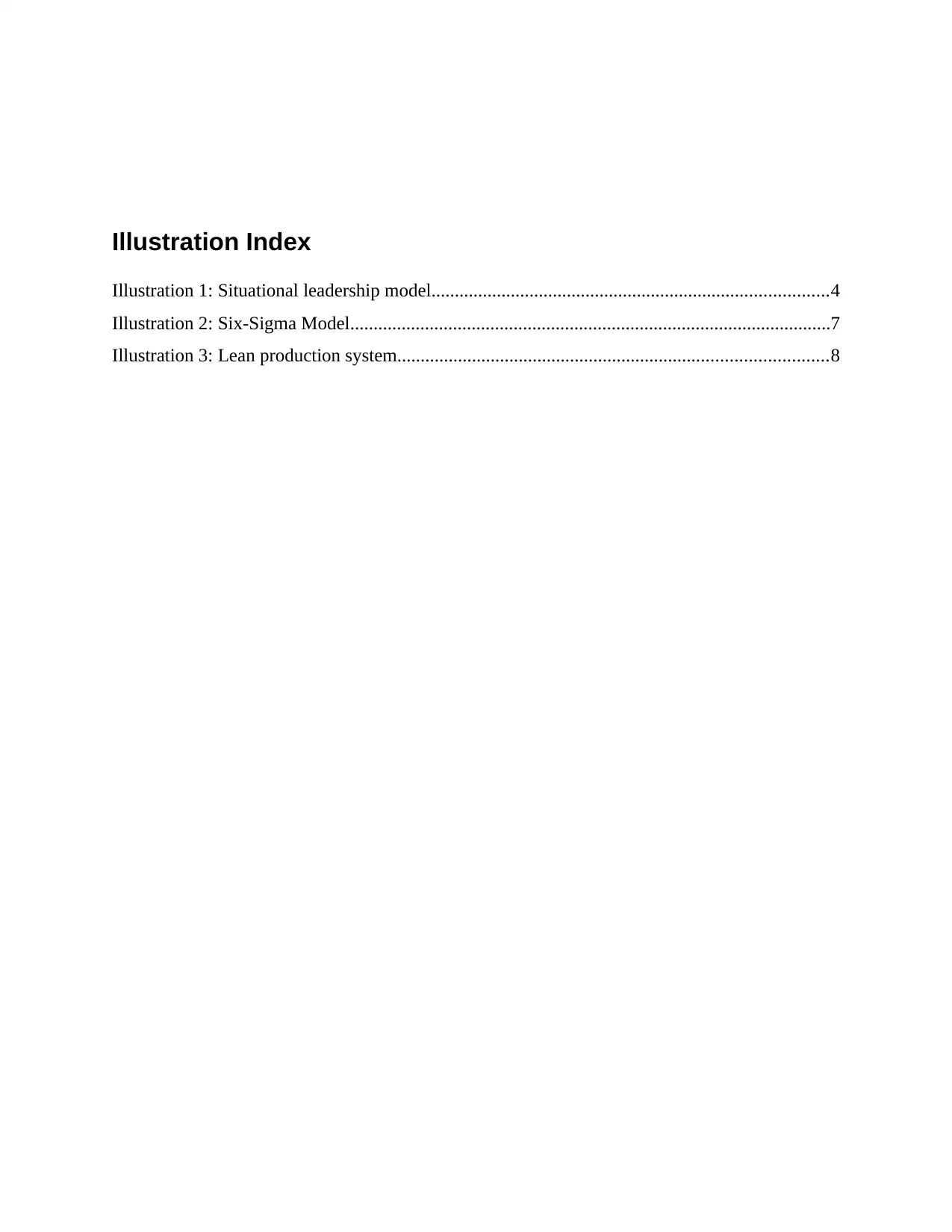
Illustration Index
Illustration 1: Situational leadership model.....................................................................................4
Illustration 2: Six-Sigma Model.......................................................................................................7
Illustration 3: Lean production system............................................................................................8
Illustration 1: Situational leadership model.....................................................................................4
Illustration 2: Six-Sigma Model.......................................................................................................7
Illustration 3: Lean production system............................................................................................8
⊘ This is a preview!⊘
Do you want full access?
Subscribe today to unlock all pages.

Trusted by 1+ million students worldwide
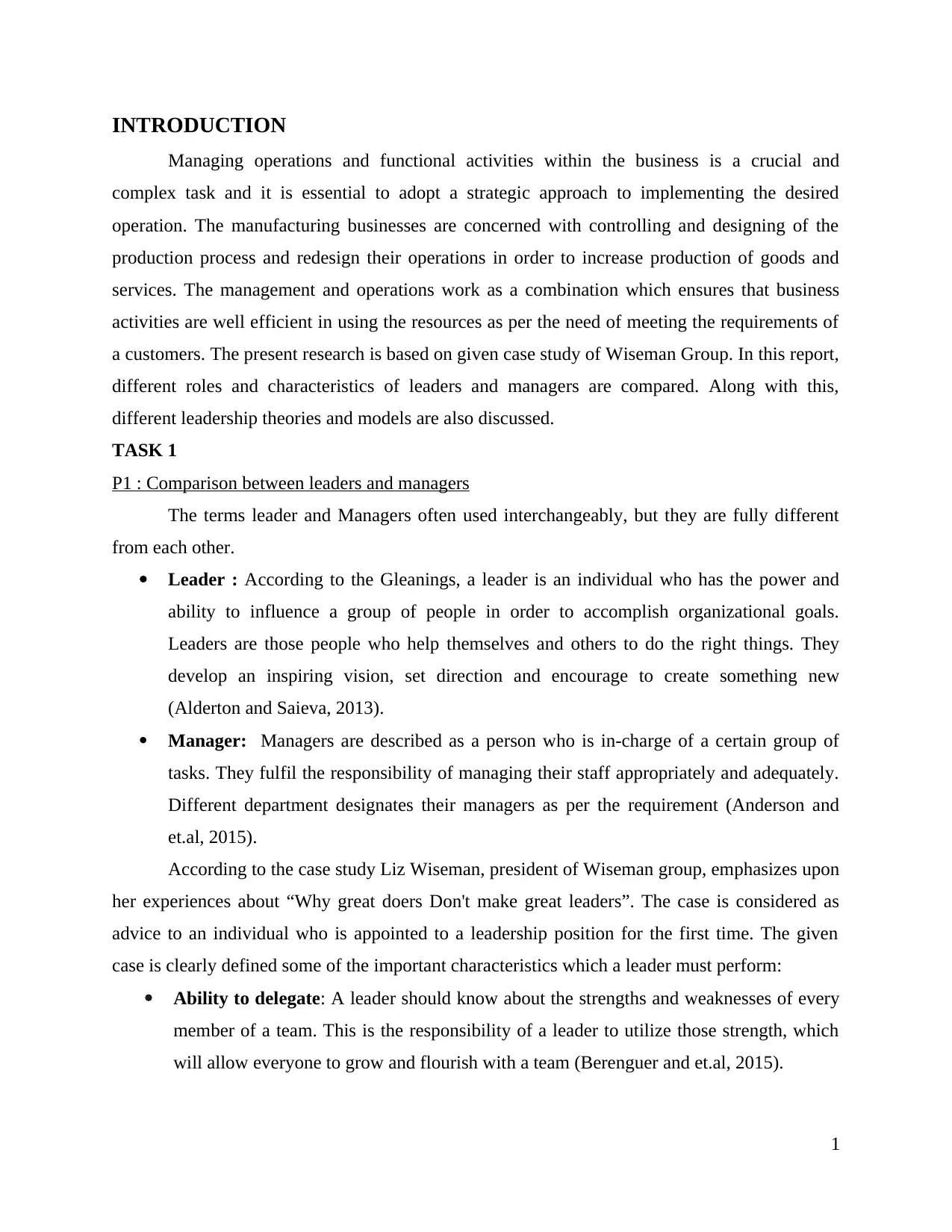
INTRODUCTION
Managing operations and functional activities within the business is a crucial and
complex task and it is essential to adopt a strategic approach to implementing the desired
operation. The manufacturing businesses are concerned with controlling and designing of the
production process and redesign their operations in order to increase production of goods and
services. The management and operations work as a combination which ensures that business
activities are well efficient in using the resources as per the need of meeting the requirements of
a customers. The present research is based on given case study of Wiseman Group. In this report,
different roles and characteristics of leaders and managers are compared. Along with this,
different leadership theories and models are also discussed.
TASK 1
P1 : Comparison between leaders and managers
The terms leader and Managers often used interchangeably, but they are fully different
from each other.
Leader : According to the Gleanings, a leader is an individual who has the power and
ability to influence a group of people in order to accomplish organizational goals.
Leaders are those people who help themselves and others to do the right things. They
develop an inspiring vision, set direction and encourage to create something new
(Alderton and Saieva, 2013).
Manager: Managers are described as a person who is in-charge of a certain group of
tasks. They fulfil the responsibility of managing their staff appropriately and adequately.
Different department designates their managers as per the requirement (Anderson and
et.al, 2015).
According to the case study Liz Wiseman, president of Wiseman group, emphasizes upon
her experiences about “Why great doers Don't make great leaders”. The case is considered as
advice to an individual who is appointed to a leadership position for the first time. The given
case is clearly defined some of the important characteristics which a leader must perform:
Ability to delegate: A leader should know about the strengths and weaknesses of every
member of a team. This is the responsibility of a leader to utilize those strength, which
will allow everyone to grow and flourish with a team (Berenguer and et.al, 2015).
1
Managing operations and functional activities within the business is a crucial and
complex task and it is essential to adopt a strategic approach to implementing the desired
operation. The manufacturing businesses are concerned with controlling and designing of the
production process and redesign their operations in order to increase production of goods and
services. The management and operations work as a combination which ensures that business
activities are well efficient in using the resources as per the need of meeting the requirements of
a customers. The present research is based on given case study of Wiseman Group. In this report,
different roles and characteristics of leaders and managers are compared. Along with this,
different leadership theories and models are also discussed.
TASK 1
P1 : Comparison between leaders and managers
The terms leader and Managers often used interchangeably, but they are fully different
from each other.
Leader : According to the Gleanings, a leader is an individual who has the power and
ability to influence a group of people in order to accomplish organizational goals.
Leaders are those people who help themselves and others to do the right things. They
develop an inspiring vision, set direction and encourage to create something new
(Alderton and Saieva, 2013).
Manager: Managers are described as a person who is in-charge of a certain group of
tasks. They fulfil the responsibility of managing their staff appropriately and adequately.
Different department designates their managers as per the requirement (Anderson and
et.al, 2015).
According to the case study Liz Wiseman, president of Wiseman group, emphasizes upon
her experiences about “Why great doers Don't make great leaders”. The case is considered as
advice to an individual who is appointed to a leadership position for the first time. The given
case is clearly defined some of the important characteristics which a leader must perform:
Ability to delegate: A leader should know about the strengths and weaknesses of every
member of a team. This is the responsibility of a leader to utilize those strength, which
will allow everyone to grow and flourish with a team (Berenguer and et.al, 2015).
1
Paraphrase This Document
Need a fresh take? Get an instant paraphrase of this document with our AI Paraphraser
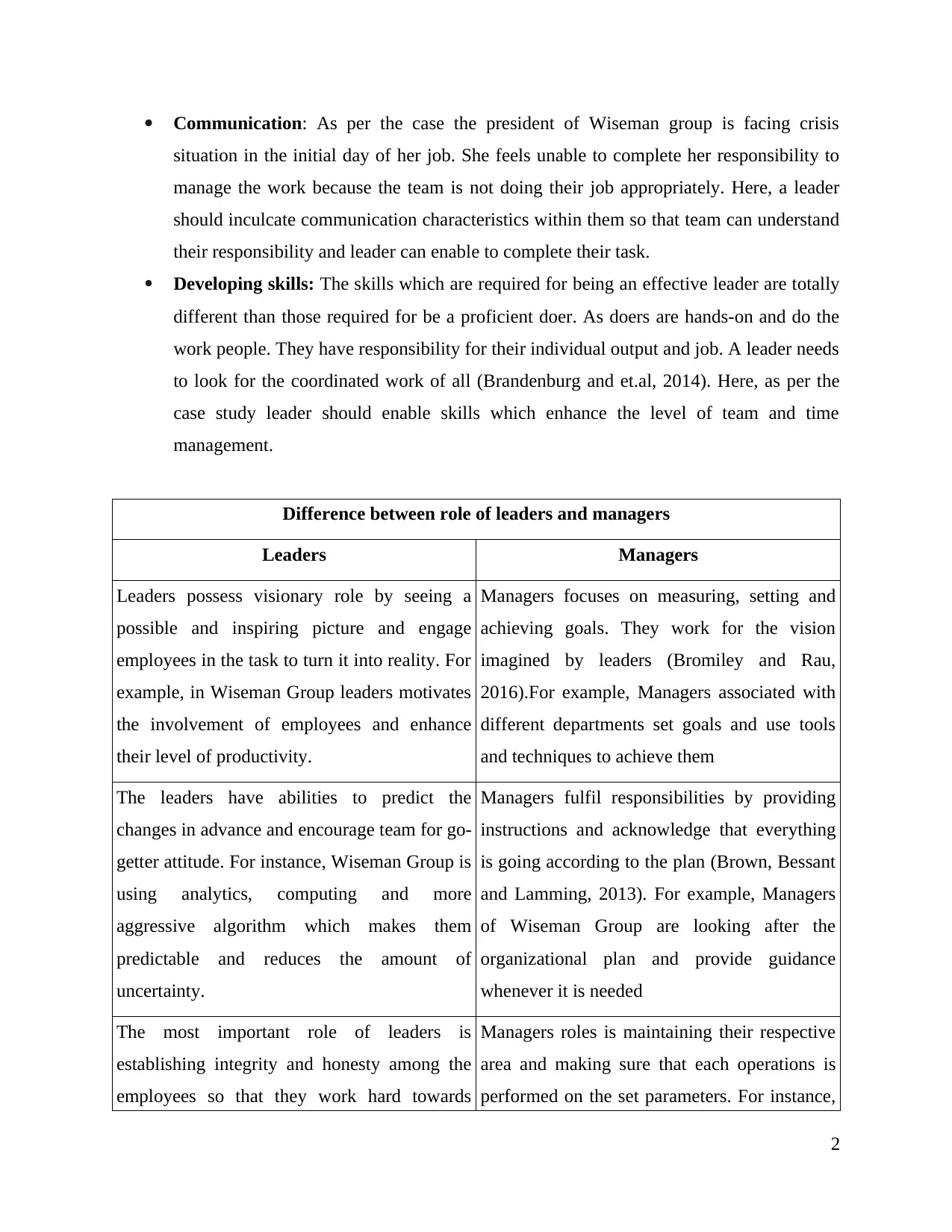
Communication: As per the case the president of Wiseman group is facing crisis
situation in the initial day of her job. She feels unable to complete her responsibility to
manage the work because the team is not doing their job appropriately. Here, a leader
should inculcate communication characteristics within them so that team can understand
their responsibility and leader can enable to complete their task.
Developing skills: The skills which are required for being an effective leader are totally
different than those required for be a proficient doer. As doers are hands-on and do the
work people. They have responsibility for their individual output and job. A leader needs
to look for the coordinated work of all (Brandenburg and et.al, 2014). Here, as per the
case study leader should enable skills which enhance the level of team and time
management.
Difference between role of leaders and managers
Leaders Managers
Leaders possess visionary role by seeing a
possible and inspiring picture and engage
employees in the task to turn it into reality. For
example, in Wiseman Group leaders motivates
the involvement of employees and enhance
their level of productivity.
Managers focuses on measuring, setting and
achieving goals. They work for the vision
imagined by leaders (Bromiley and Rau,
2016).For example, Managers associated with
different departments set goals and use tools
and techniques to achieve them
The leaders have abilities to predict the
changes in advance and encourage team for go-
getter attitude. For instance, Wiseman Group is
using analytics, computing and more
aggressive algorithm which makes them
predictable and reduces the amount of
uncertainty.
Managers fulfil responsibilities by providing
instructions and acknowledge that everything
is going according to the plan (Brown, Bessant
and Lamming, 2013). For example, Managers
of Wiseman Group are looking after the
organizational plan and provide guidance
whenever it is needed
The most important role of leaders is
establishing integrity and honesty among the
employees so that they work hard towards
Managers roles is maintaining their respective
area and making sure that each operations is
performed on the set parameters. For instance,
2
situation in the initial day of her job. She feels unable to complete her responsibility to
manage the work because the team is not doing their job appropriately. Here, a leader
should inculcate communication characteristics within them so that team can understand
their responsibility and leader can enable to complete their task.
Developing skills: The skills which are required for being an effective leader are totally
different than those required for be a proficient doer. As doers are hands-on and do the
work people. They have responsibility for their individual output and job. A leader needs
to look for the coordinated work of all (Brandenburg and et.al, 2014). Here, as per the
case study leader should enable skills which enhance the level of team and time
management.
Difference between role of leaders and managers
Leaders Managers
Leaders possess visionary role by seeing a
possible and inspiring picture and engage
employees in the task to turn it into reality. For
example, in Wiseman Group leaders motivates
the involvement of employees and enhance
their level of productivity.
Managers focuses on measuring, setting and
achieving goals. They work for the vision
imagined by leaders (Bromiley and Rau,
2016).For example, Managers associated with
different departments set goals and use tools
and techniques to achieve them
The leaders have abilities to predict the
changes in advance and encourage team for go-
getter attitude. For instance, Wiseman Group is
using analytics, computing and more
aggressive algorithm which makes them
predictable and reduces the amount of
uncertainty.
Managers fulfil responsibilities by providing
instructions and acknowledge that everything
is going according to the plan (Brown, Bessant
and Lamming, 2013). For example, Managers
of Wiseman Group are looking after the
organizational plan and provide guidance
whenever it is needed
The most important role of leaders is
establishing integrity and honesty among the
employees so that they work hard towards
Managers roles is maintaining their respective
area and making sure that each operations is
performed on the set parameters. For instance,
2
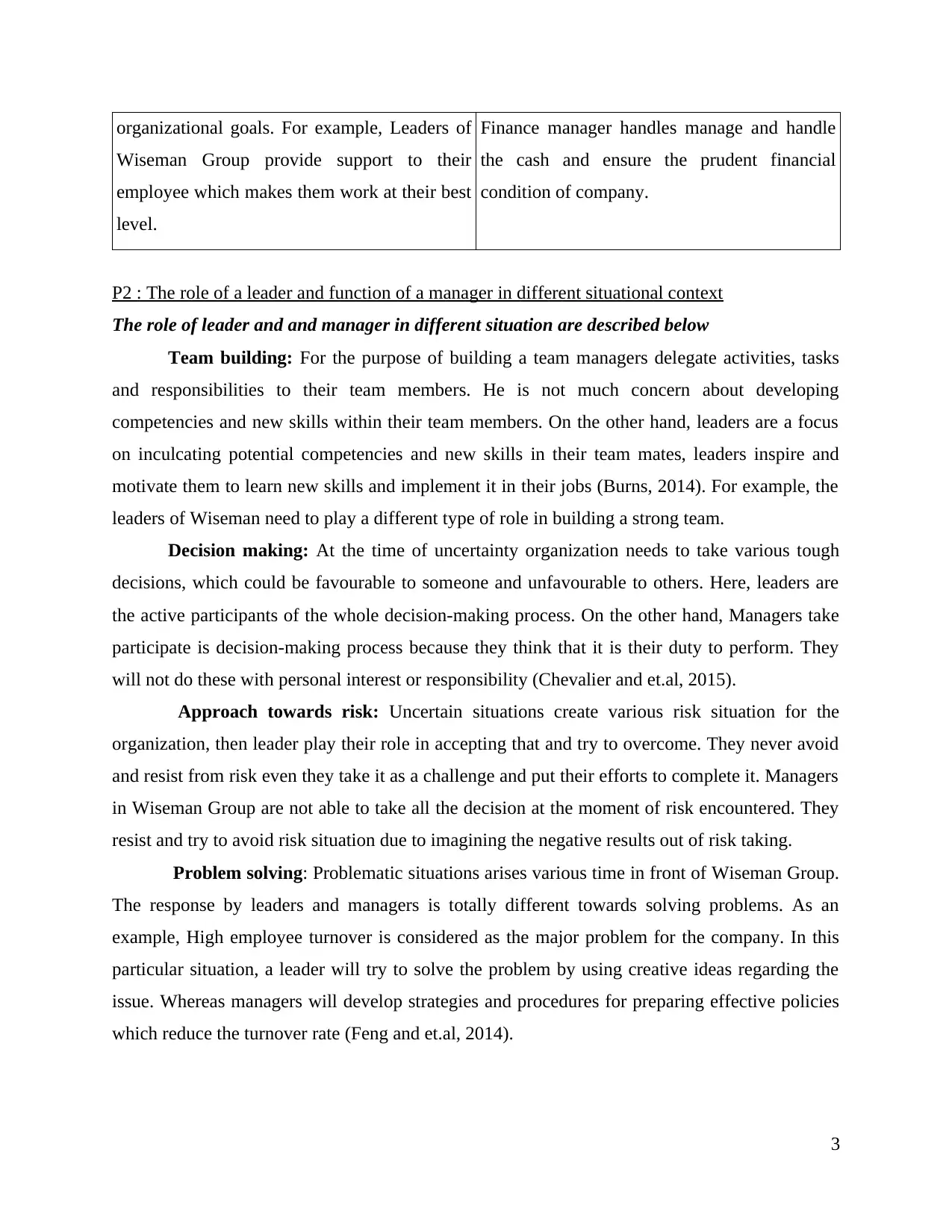
organizational goals. For example, Leaders of
Wiseman Group provide support to their
employee which makes them work at their best
level.
Finance manager handles manage and handle
the cash and ensure the prudent financial
condition of company.
P2 : The role of a leader and function of a manager in different situational context
The role of leader and and manager in different situation are described below
Team building: For the purpose of building a team managers delegate activities, tasks
and responsibilities to their team members. He is not much concern about developing
competencies and new skills within their team members. On the other hand, leaders are a focus
on inculcating potential competencies and new skills in their team mates, leaders inspire and
motivate them to learn new skills and implement it in their jobs (Burns, 2014). For example, the
leaders of Wiseman need to play a different type of role in building a strong team.
Decision making: At the time of uncertainty organization needs to take various tough
decisions, which could be favourable to someone and unfavourable to others. Here, leaders are
the active participants of the whole decision-making process. On the other hand, Managers take
participate is decision-making process because they think that it is their duty to perform. They
will not do these with personal interest or responsibility (Chevalier and et.al, 2015).
Approach towards risk: Uncertain situations create various risk situation for the
organization, then leader play their role in accepting that and try to overcome. They never avoid
and resist from risk even they take it as a challenge and put their efforts to complete it. Managers
in Wiseman Group are not able to take all the decision at the moment of risk encountered. They
resist and try to avoid risk situation due to imagining the negative results out of risk taking.
Problem solving: Problematic situations arises various time in front of Wiseman Group.
The response by leaders and managers is totally different towards solving problems. As an
example, High employee turnover is considered as the major problem for the company. In this
particular situation, a leader will try to solve the problem by using creative ideas regarding the
issue. Whereas managers will develop strategies and procedures for preparing effective policies
which reduce the turnover rate (Feng and et.al, 2014).
3
Wiseman Group provide support to their
employee which makes them work at their best
level.
Finance manager handles manage and handle
the cash and ensure the prudent financial
condition of company.
P2 : The role of a leader and function of a manager in different situational context
The role of leader and and manager in different situation are described below
Team building: For the purpose of building a team managers delegate activities, tasks
and responsibilities to their team members. He is not much concern about developing
competencies and new skills within their team members. On the other hand, leaders are a focus
on inculcating potential competencies and new skills in their team mates, leaders inspire and
motivate them to learn new skills and implement it in their jobs (Burns, 2014). For example, the
leaders of Wiseman need to play a different type of role in building a strong team.
Decision making: At the time of uncertainty organization needs to take various tough
decisions, which could be favourable to someone and unfavourable to others. Here, leaders are
the active participants of the whole decision-making process. On the other hand, Managers take
participate is decision-making process because they think that it is their duty to perform. They
will not do these with personal interest or responsibility (Chevalier and et.al, 2015).
Approach towards risk: Uncertain situations create various risk situation for the
organization, then leader play their role in accepting that and try to overcome. They never avoid
and resist from risk even they take it as a challenge and put their efforts to complete it. Managers
in Wiseman Group are not able to take all the decision at the moment of risk encountered. They
resist and try to avoid risk situation due to imagining the negative results out of risk taking.
Problem solving: Problematic situations arises various time in front of Wiseman Group.
The response by leaders and managers is totally different towards solving problems. As an
example, High employee turnover is considered as the major problem for the company. In this
particular situation, a leader will try to solve the problem by using creative ideas regarding the
issue. Whereas managers will develop strategies and procedures for preparing effective policies
which reduce the turnover rate (Feng and et.al, 2014).
3
⊘ This is a preview!⊘
Do you want full access?
Subscribe today to unlock all pages.

Trusted by 1+ million students worldwide
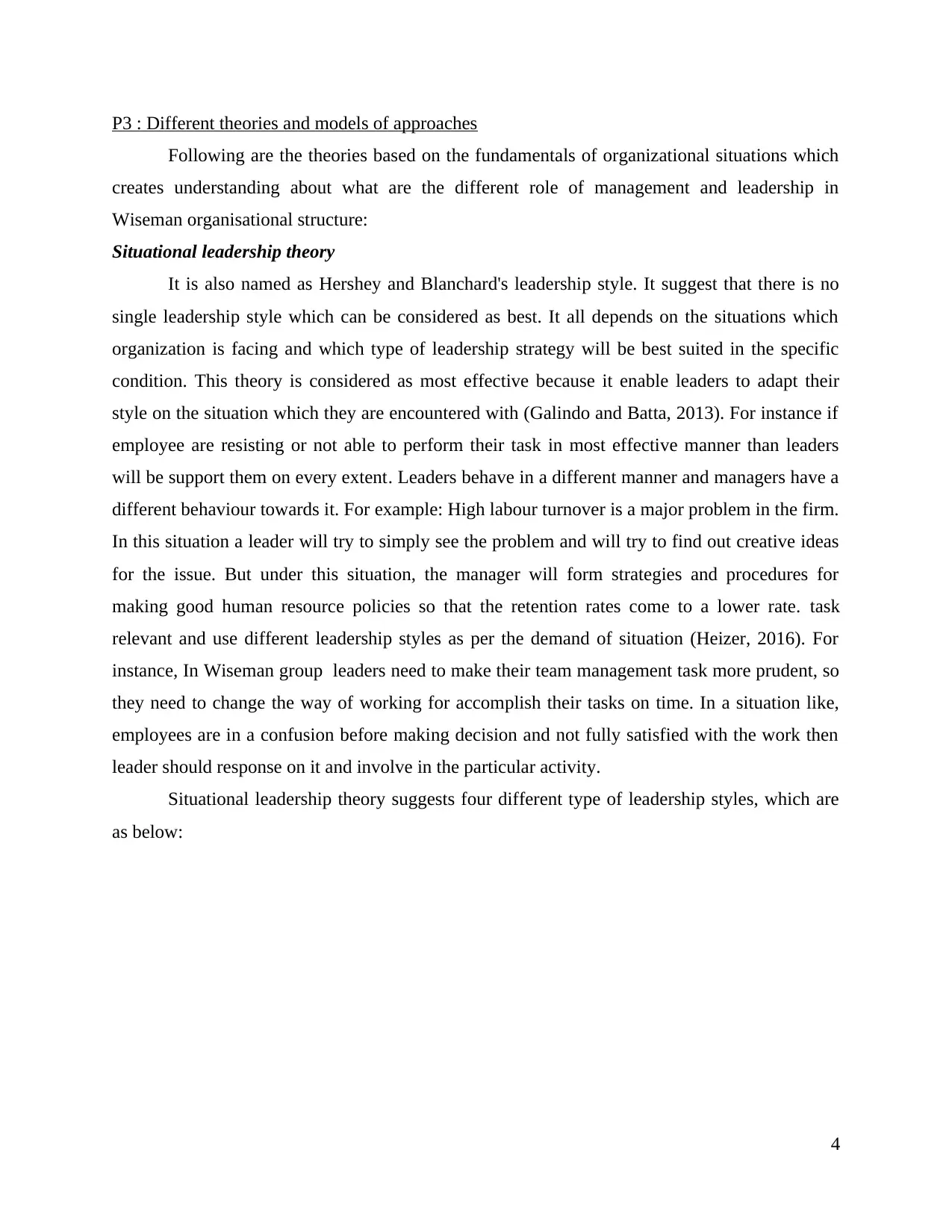
P3 : Different theories and models of approaches
Following are the theories based on the fundamentals of organizational situations which
creates understanding about what are the different role of management and leadership in
Wiseman organisational structure:
Situational leadership theory
It is also named as Hershey and Blanchard's leadership style. It suggest that there is no
single leadership style which can be considered as best. It all depends on the situations which
organization is facing and which type of leadership strategy will be best suited in the specific
condition. This theory is considered as most effective because it enable leaders to adapt their
style on the situation which they are encountered with (Galindo and Batta, 2013). For instance if
employee are resisting or not able to perform their task in most effective manner than leaders
will be support them on every extent. Leaders behave in a different manner and managers have a
different behaviour towards it. For example: High labour turnover is a major problem in the firm.
In this situation a leader will try to simply see the problem and will try to find out creative ideas
for the issue. But under this situation, the manager will form strategies and procedures for
making good human resource policies so that the retention rates come to a lower rate. task
relevant and use different leadership styles as per the demand of situation (Heizer, 2016). For
instance, In Wiseman group leaders need to make their team management task more prudent, so
they need to change the way of working for accomplish their tasks on time. In a situation like,
employees are in a confusion before making decision and not fully satisfied with the work then
leader should response on it and involve in the particular activity.
Situational leadership theory suggests four different type of leadership styles, which are
as below:
4
Following are the theories based on the fundamentals of organizational situations which
creates understanding about what are the different role of management and leadership in
Wiseman organisational structure:
Situational leadership theory
It is also named as Hershey and Blanchard's leadership style. It suggest that there is no
single leadership style which can be considered as best. It all depends on the situations which
organization is facing and which type of leadership strategy will be best suited in the specific
condition. This theory is considered as most effective because it enable leaders to adapt their
style on the situation which they are encountered with (Galindo and Batta, 2013). For instance if
employee are resisting or not able to perform their task in most effective manner than leaders
will be support them on every extent. Leaders behave in a different manner and managers have a
different behaviour towards it. For example: High labour turnover is a major problem in the firm.
In this situation a leader will try to simply see the problem and will try to find out creative ideas
for the issue. But under this situation, the manager will form strategies and procedures for
making good human resource policies so that the retention rates come to a lower rate. task
relevant and use different leadership styles as per the demand of situation (Heizer, 2016). For
instance, In Wiseman group leaders need to make their team management task more prudent, so
they need to change the way of working for accomplish their tasks on time. In a situation like,
employees are in a confusion before making decision and not fully satisfied with the work then
leader should response on it and involve in the particular activity.
Situational leadership theory suggests four different type of leadership styles, which are
as below:
4
Paraphrase This Document
Need a fresh take? Get an instant paraphrase of this document with our AI Paraphraser
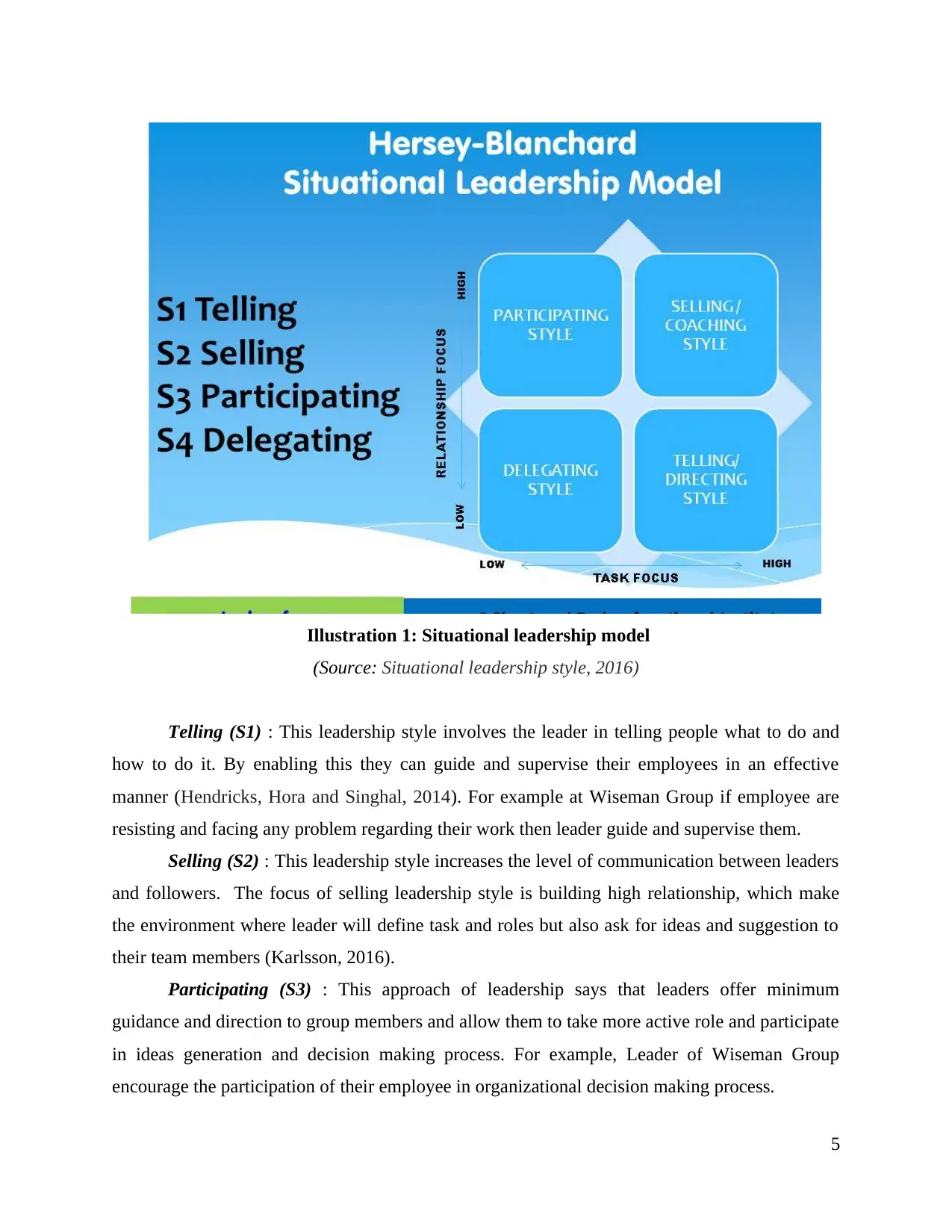
Illustration 1: Situational leadership model
(Source: Situational leadership style, 2016)
Telling (S1) : This leadership style involves the leader in telling people what to do and
how to do it. By enabling this they can guide and supervise their employees in an effective
manner (Hendricks, Hora and Singhal, 2014). For example at Wiseman Group if employee are
resisting and facing any problem regarding their work then leader guide and supervise them.
Selling (S2) : This leadership style increases the level of communication between leaders
and followers. The focus of selling leadership style is building high relationship, which make
the environment where leader will define task and roles but also ask for ideas and suggestion to
their team members (Karlsson, 2016).
Participating (S3) : This approach of leadership says that leaders offer minimum
guidance and direction to group members and allow them to take more active role and participate
in ideas generation and decision making process. For example, Leader of Wiseman Group
encourage the participation of their employee in organizational decision making process.
5
(Source: Situational leadership style, 2016)
Telling (S1) : This leadership style involves the leader in telling people what to do and
how to do it. By enabling this they can guide and supervise their employees in an effective
manner (Hendricks, Hora and Singhal, 2014). For example at Wiseman Group if employee are
resisting and facing any problem regarding their work then leader guide and supervise them.
Selling (S2) : This leadership style increases the level of communication between leaders
and followers. The focus of selling leadership style is building high relationship, which make
the environment where leader will define task and roles but also ask for ideas and suggestion to
their team members (Karlsson, 2016).
Participating (S3) : This approach of leadership says that leaders offer minimum
guidance and direction to group members and allow them to take more active role and participate
in ideas generation and decision making process. For example, Leader of Wiseman Group
encourage the participation of their employee in organizational decision making process.
5
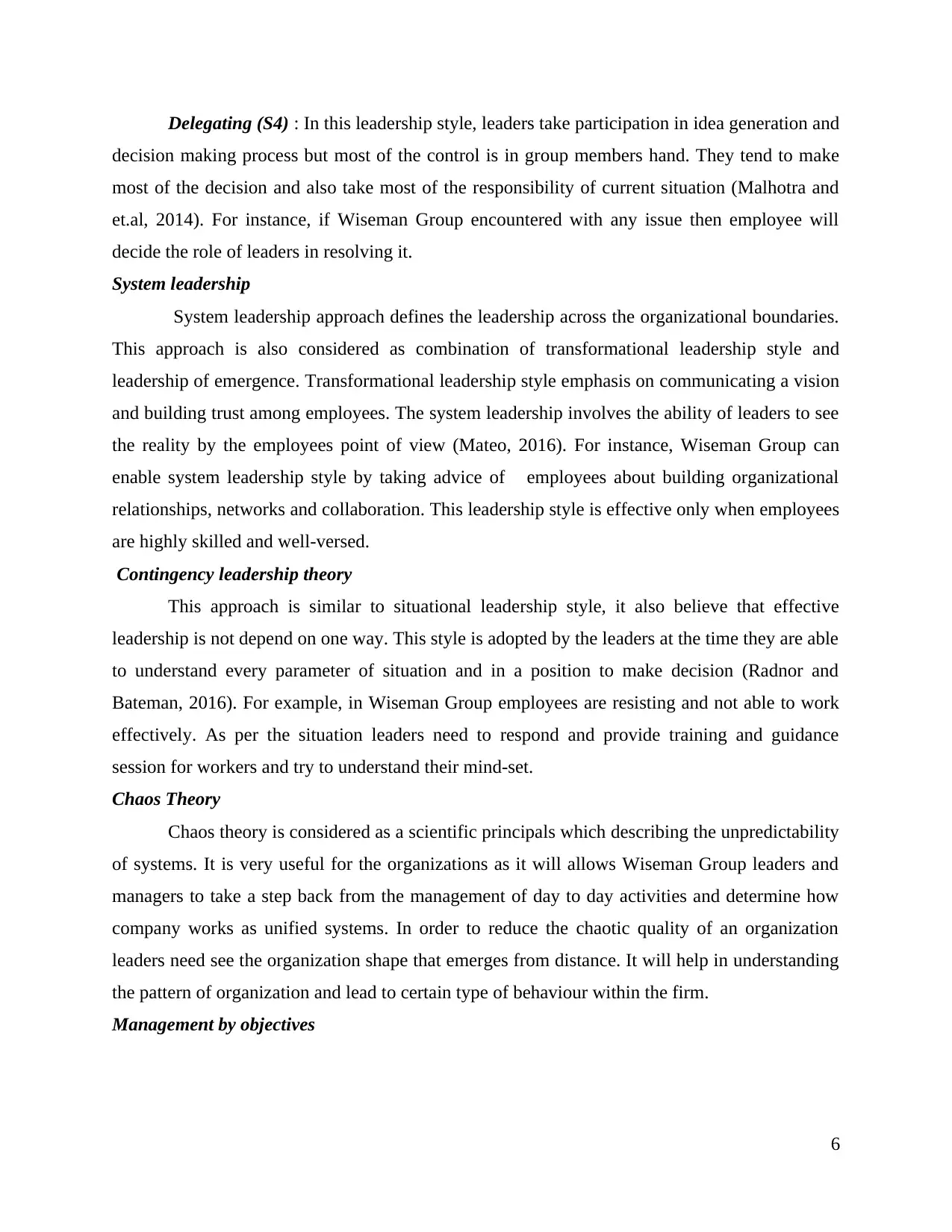
Delegating (S4) : In this leadership style, leaders take participation in idea generation and
decision making process but most of the control is in group members hand. They tend to make
most of the decision and also take most of the responsibility of current situation (Malhotra and
et.al, 2014). For instance, if Wiseman Group encountered with any issue then employee will
decide the role of leaders in resolving it.
System leadership
System leadership approach defines the leadership across the organizational boundaries.
This approach is also considered as combination of transformational leadership style and
leadership of emergence. Transformational leadership style emphasis on communicating a vision
and building trust among employees. The system leadership involves the ability of leaders to see
the reality by the employees point of view (Mateo, 2016). For instance, Wiseman Group can
enable system leadership style by taking advice of employees about building organizational
relationships, networks and collaboration. This leadership style is effective only when employees
are highly skilled and well-versed.
Contingency leadership theory
This approach is similar to situational leadership style, it also believe that effective
leadership is not depend on one way. This style is adopted by the leaders at the time they are able
to understand every parameter of situation and in a position to make decision (Radnor and
Bateman, 2016). For example, in Wiseman Group employees are resisting and not able to work
effectively. As per the situation leaders need to respond and provide training and guidance
session for workers and try to understand their mind-set.
Chaos Theory
Chaos theory is considered as a scientific principals which describing the unpredictability
of systems. It is very useful for the organizations as it will allows Wiseman Group leaders and
managers to take a step back from the management of day to day activities and determine how
company works as unified systems. In order to reduce the chaotic quality of an organization
leaders need see the organization shape that emerges from distance. It will help in understanding
the pattern of organization and lead to certain type of behaviour within the firm.
Management by objectives
6
decision making process but most of the control is in group members hand. They tend to make
most of the decision and also take most of the responsibility of current situation (Malhotra and
et.al, 2014). For instance, if Wiseman Group encountered with any issue then employee will
decide the role of leaders in resolving it.
System leadership
System leadership approach defines the leadership across the organizational boundaries.
This approach is also considered as combination of transformational leadership style and
leadership of emergence. Transformational leadership style emphasis on communicating a vision
and building trust among employees. The system leadership involves the ability of leaders to see
the reality by the employees point of view (Mateo, 2016). For instance, Wiseman Group can
enable system leadership style by taking advice of employees about building organizational
relationships, networks and collaboration. This leadership style is effective only when employees
are highly skilled and well-versed.
Contingency leadership theory
This approach is similar to situational leadership style, it also believe that effective
leadership is not depend on one way. This style is adopted by the leaders at the time they are able
to understand every parameter of situation and in a position to make decision (Radnor and
Bateman, 2016). For example, in Wiseman Group employees are resisting and not able to work
effectively. As per the situation leaders need to respond and provide training and guidance
session for workers and try to understand their mind-set.
Chaos Theory
Chaos theory is considered as a scientific principals which describing the unpredictability
of systems. It is very useful for the organizations as it will allows Wiseman Group leaders and
managers to take a step back from the management of day to day activities and determine how
company works as unified systems. In order to reduce the chaotic quality of an organization
leaders need see the organization shape that emerges from distance. It will help in understanding
the pattern of organization and lead to certain type of behaviour within the firm.
Management by objectives
6
⊘ This is a preview!⊘
Do you want full access?
Subscribe today to unlock all pages.

Trusted by 1+ million students worldwide
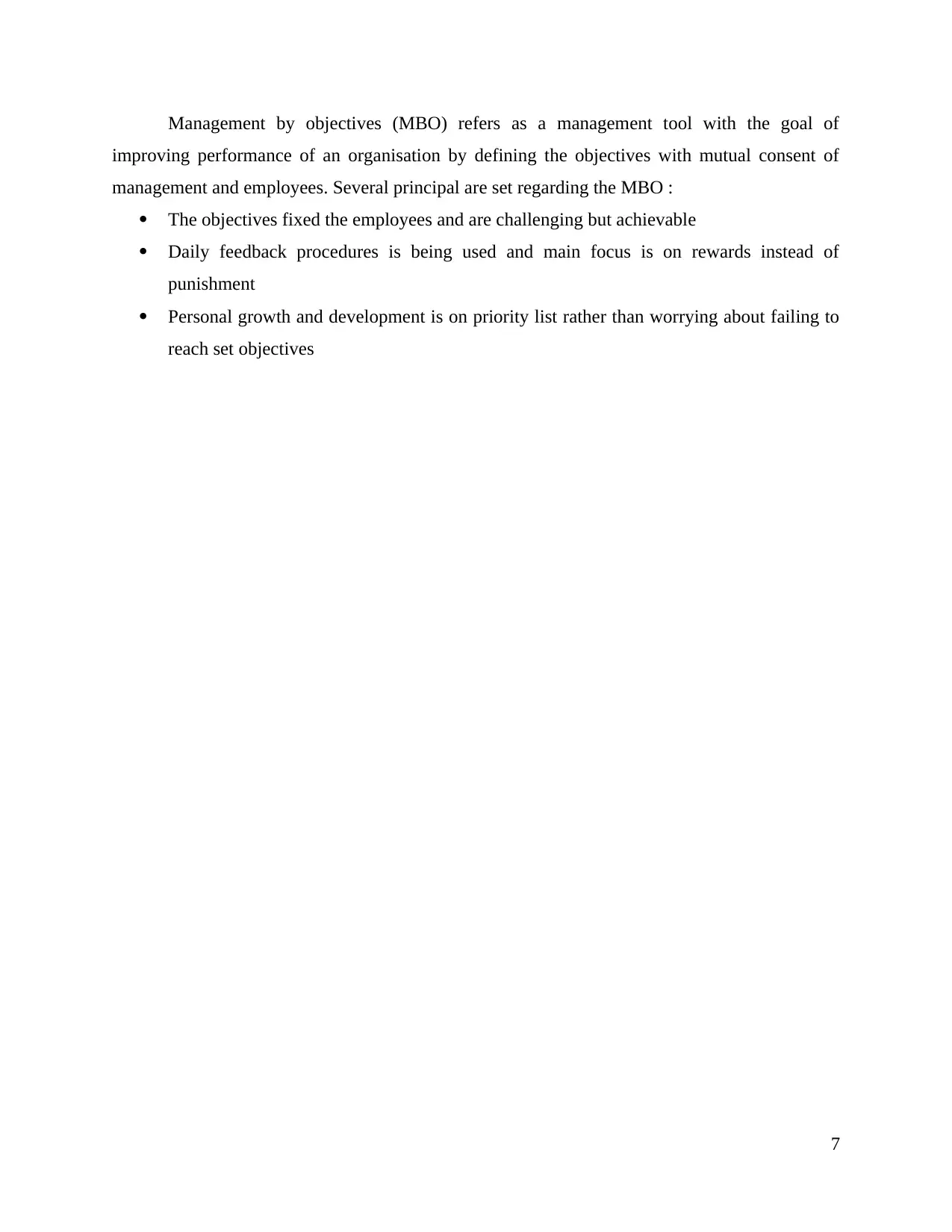
Management by objectives (MBO) refers as a management tool with the goal of
improving performance of an organisation by defining the objectives with mutual consent of
management and employees. Several principal are set regarding the MBO :
The objectives fixed the employees and are challenging but achievable
Daily feedback procedures is being used and main focus is on rewards instead of
punishment
Personal growth and development is on priority list rather than worrying about failing to
reach set objectives
7
improving performance of an organisation by defining the objectives with mutual consent of
management and employees. Several principal are set regarding the MBO :
The objectives fixed the employees and are challenging but achievable
Daily feedback procedures is being used and main focus is on rewards instead of
punishment
Personal growth and development is on priority list rather than worrying about failing to
reach set objectives
7
Paraphrase This Document
Need a fresh take? Get an instant paraphrase of this document with our AI Paraphraser
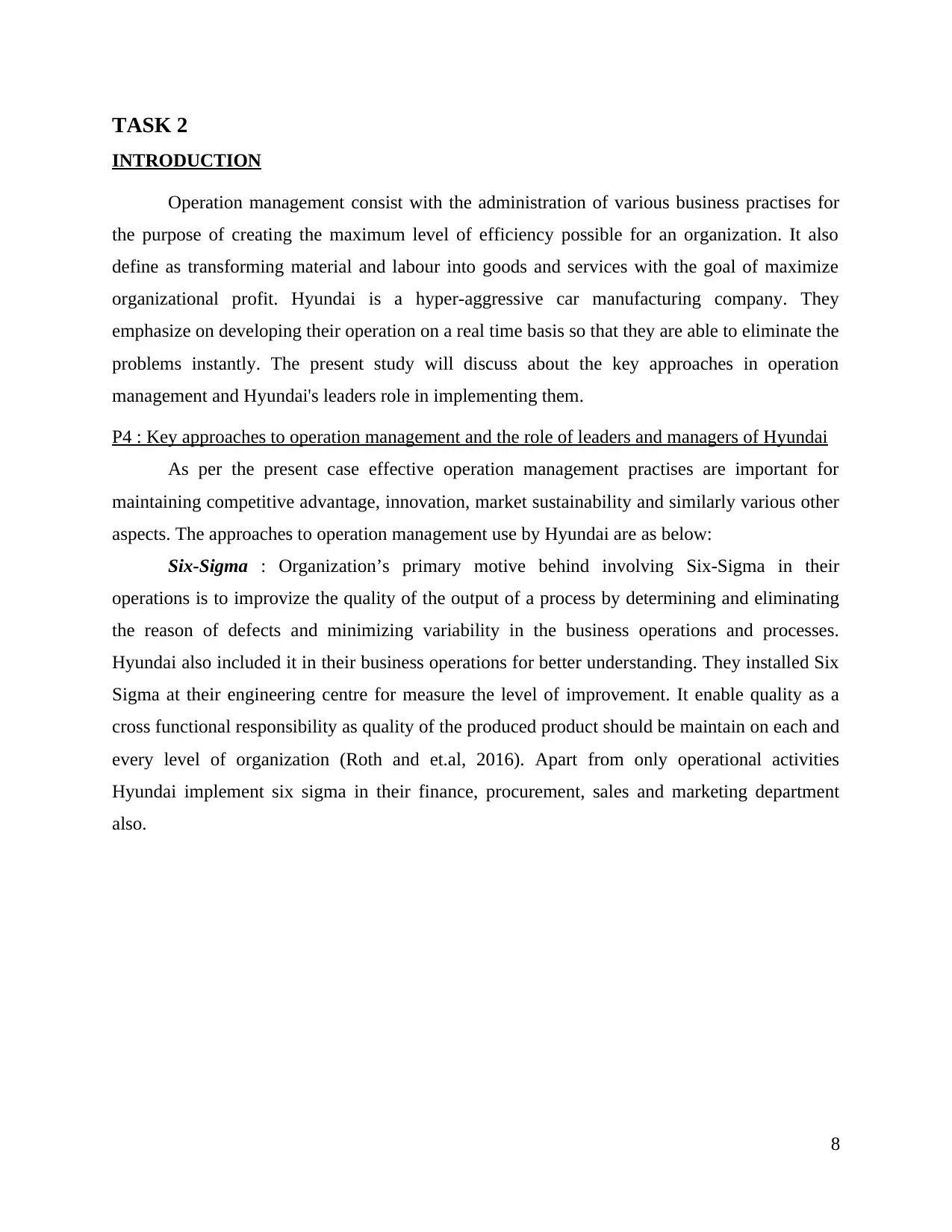
TASK 2
INTRODUCTION
Operation management consist with the administration of various business practises for
the purpose of creating the maximum level of efficiency possible for an organization. It also
define as transforming material and labour into goods and services with the goal of maximize
organizational profit. Hyundai is a hyper-aggressive car manufacturing company. They
emphasize on developing their operation on a real time basis so that they are able to eliminate the
problems instantly. The present study will discuss about the key approaches in operation
management and Hyundai's leaders role in implementing them.
P4 : Key approaches to operation management and the role of leaders and managers of Hyundai
As per the present case effective operation management practises are important for
maintaining competitive advantage, innovation, market sustainability and similarly various other
aspects. The approaches to operation management use by Hyundai are as below:
Six-Sigma : Organization’s primary motive behind involving Six-Sigma in their
operations is to improvize the quality of the output of a process by determining and eliminating
the reason of defects and minimizing variability in the business operations and processes.
Hyundai also included it in their business operations for better understanding. They installed Six
Sigma at their engineering centre for measure the level of improvement. It enable quality as a
cross functional responsibility as quality of the produced product should be maintain on each and
every level of organization (Roth and et.al, 2016). Apart from only operational activities
Hyundai implement six sigma in their finance, procurement, sales and marketing department
also.
8
INTRODUCTION
Operation management consist with the administration of various business practises for
the purpose of creating the maximum level of efficiency possible for an organization. It also
define as transforming material and labour into goods and services with the goal of maximize
organizational profit. Hyundai is a hyper-aggressive car manufacturing company. They
emphasize on developing their operation on a real time basis so that they are able to eliminate the
problems instantly. The present study will discuss about the key approaches in operation
management and Hyundai's leaders role in implementing them.
P4 : Key approaches to operation management and the role of leaders and managers of Hyundai
As per the present case effective operation management practises are important for
maintaining competitive advantage, innovation, market sustainability and similarly various other
aspects. The approaches to operation management use by Hyundai are as below:
Six-Sigma : Organization’s primary motive behind involving Six-Sigma in their
operations is to improvize the quality of the output of a process by determining and eliminating
the reason of defects and minimizing variability in the business operations and processes.
Hyundai also included it in their business operations for better understanding. They installed Six
Sigma at their engineering centre for measure the level of improvement. It enable quality as a
cross functional responsibility as quality of the produced product should be maintain on each and
every level of organization (Roth and et.al, 2016). Apart from only operational activities
Hyundai implement six sigma in their finance, procurement, sales and marketing department
also.
8
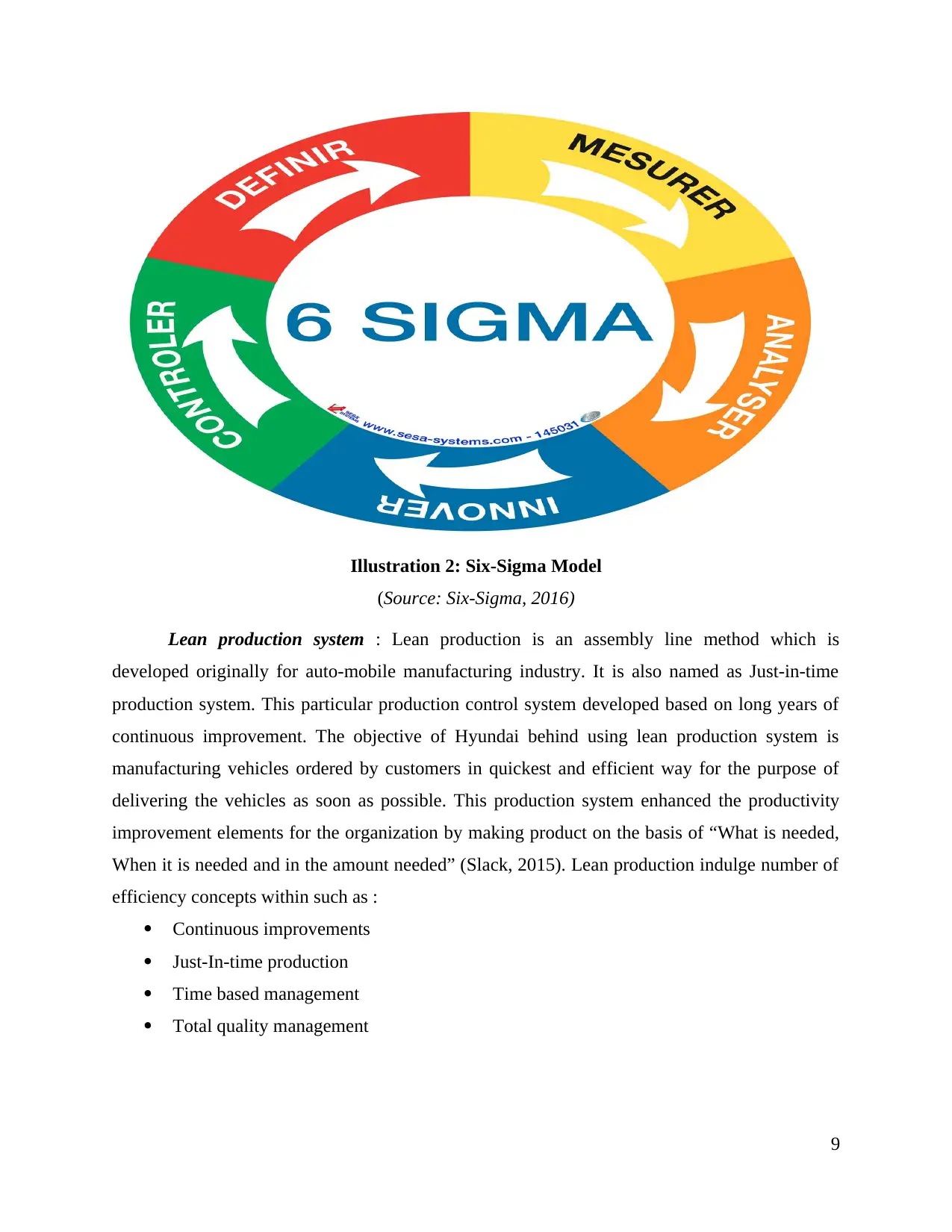
Illustration 2: Six-Sigma Model
(Source: Six-Sigma, 2016)
Lean production system : Lean production is an assembly line method which is
developed originally for auto-mobile manufacturing industry. It is also named as Just-in-time
production system. This particular production control system developed based on long years of
continuous improvement. The objective of Hyundai behind using lean production system is
manufacturing vehicles ordered by customers in quickest and efficient way for the purpose of
delivering the vehicles as soon as possible. This production system enhanced the productivity
improvement elements for the organization by making product on the basis of “What is needed,
When it is needed and in the amount needed” (Slack, 2015). Lean production indulge number of
efficiency concepts within such as :
Continuous improvements
Just-In-time production
Time based management
Total quality management
9
(Source: Six-Sigma, 2016)
Lean production system : Lean production is an assembly line method which is
developed originally for auto-mobile manufacturing industry. It is also named as Just-in-time
production system. This particular production control system developed based on long years of
continuous improvement. The objective of Hyundai behind using lean production system is
manufacturing vehicles ordered by customers in quickest and efficient way for the purpose of
delivering the vehicles as soon as possible. This production system enhanced the productivity
improvement elements for the organization by making product on the basis of “What is needed,
When it is needed and in the amount needed” (Slack, 2015). Lean production indulge number of
efficiency concepts within such as :
Continuous improvements
Just-In-time production
Time based management
Total quality management
9
⊘ This is a preview!⊘
Do you want full access?
Subscribe today to unlock all pages.

Trusted by 1+ million students worldwide
1 out of 18
Related Documents
Your All-in-One AI-Powered Toolkit for Academic Success.
+13062052269
info@desklib.com
Available 24*7 on WhatsApp / Email
![[object Object]](/_next/static/media/star-bottom.7253800d.svg)
Unlock your academic potential
Copyright © 2020–2025 A2Z Services. All Rights Reserved. Developed and managed by ZUCOL.





